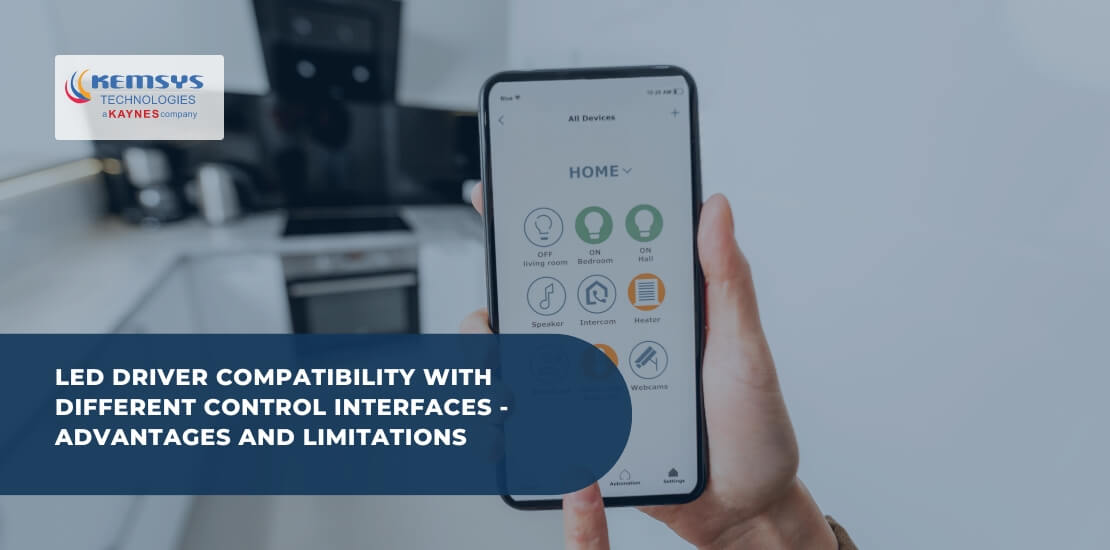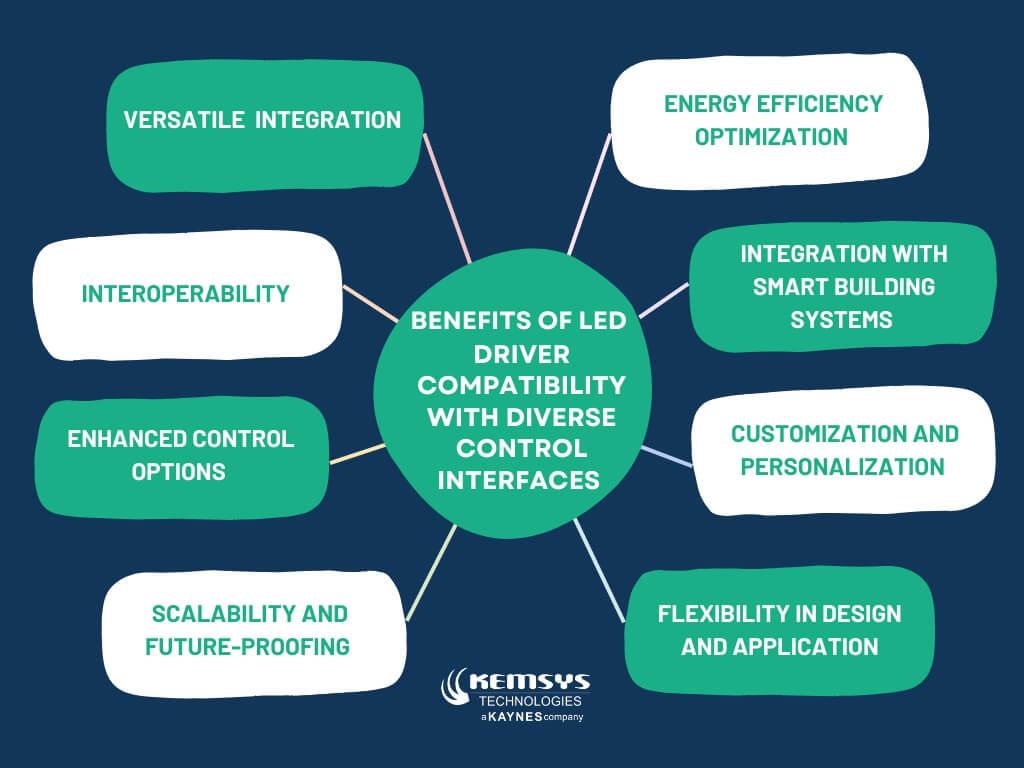- June 2, 2023
- Posted by: Swapnil Ghaisas
- Categories: Device Engineering, Internet of Things

In the world of lighting technology, Light-Emitting Diodes (LEDs) have revolutionized the way we illuminate our surroundings. These energy-efficient and versatile light sources offer a multitude of benefits, but their optimal performance relies on the seamless integration of LED drivers with various control interfaces.
LED drivers serve as the crucial link between power supply and LED fixtures. It ensures precise control over brightness, color, and other dynamic lighting features. Understanding the compatibility between LED drivers and different control interfaces is essential for unlocking the full potential of LED lighting systems.
From traditional analog control to cutting-edge digital protocols, each interface presents distinct advantages and limitations that influence the overall lighting experience. This article aims to delve into the fascinating realm of LED driver compatibility, exploring the advantages and limitations associated with various control interfaces.
Whether you’re a lighting professional seeking to maximize the potential of LED technology or an enthusiast eager to harness the transformative power of light, join us on this illuminating journey into LED driver compatibility.
Understanding Control Interfaces in Led Drivers
When it comes to LED driver compatibility with different control interfaces, understanding the various protocols and their functionalities is crucial. Each control interface operates differently and offers unique features for controlling LED lighting systems.
By familiarizing yourself with these protocols, you can make informed decisions about which interface best suits your needs. In this section, we will provide a comprehensive overview of the most common control interfaces used with LED drivers.
0-10V Dimming
- The 0-10V dimming protocol is a widely used analog control interface that allows for smooth dimming of LED fixtures.
- It operates by sending a voltage signal ranging from 0 to 10 volts to the LED driver, indicating the desired brightness level.
- This simple yet effective interface is compatible with a wide range of LED drivers and dimming devices.
Read more – Strategies to follow for Advanced Dimming LED Driver Techniques
PWM (Pulse Width Modulation)
- PWM control interfaces utilize a digital signal to control LED brightness by adjusting the duty cycle of a square wave.
- By varying the width of the pulses, the LED driver can regulate the amount of power delivered to the LEDs, resulting in dimming or color control.
- PWM is commonly employed in applications such as LED strips and color-changing lighting systems.
DMX (Digital Multiplex)
- DMX is a digital control protocol widely used in the entertainment and architectural lighting industries.
- It allows for precise control and programming of individual or groups of LED fixtures.
- DMX control interfaces employ a daisy-chain configuration, where multiple fixtures are connected in series, enabling complex lighting effects and dynamic control.
DALI (Digital Addressable Lighting Interface)
- DALI is a standardized digital lighting control protocol that offers individual addressability and dimming control for each fixture.
- It enables advanced control capabilities, including scene setting, occupancy sensing, and daylight harvesting.
- DALI control interfaces provide a reliable and flexible solution for managing LED lighting systems in commercial and architectural applications.
Wireless Control Interfaces
- With the advent of wireless technologies, LED drivers now support various wireless control interfaces like Zigbee, Bluetooth, and Wi-Fi.
- These interfaces eliminate the need for physical wiring and allow for convenient remote control and automation of LED lighting systems.
- Wireless control interfaces provide flexibility and scalability, enabling control from mobile devices or integration with smart home systems.
By understanding the fundamentals of these control interfaces, you can make informed decisions when selecting LED drivers and choosing the most suitable control protocol for your specific lighting application. In the following sections, we will delve deeper into each interface, exploring their advantages, limitations, and compatibility considerations.
Exploring the Benefits of LED Driver Compatibility with Diverse Control Interfaces

Versatile Integration
LED driver compatibility with diverse control interfaces provides the ability to integrate with various lighting control systems, including DALI, DMX, 0-10V, and more. This versatility allows for seamless integration into different environments and enables greater flexibility in lighting design.
Interoperability
LED drivers that are compatible with multiple control interfaces ensure interoperability with a wide range of lighting control devices, sensors, and systems. This compatibility promotes integration with third-party components, facilitating comprehensive lighting control solutions.
Enhanced Control Options
Compatibility with diverse control interfaces opens up a broader range of control options for LED lighting systems. It allows for precise control of parameters such as dimming, color temperature, and color mixing, enabling dynamic lighting scenes and personalized lighting experiences.
Scalability and Future-Proofing
LED drivers with compatibility across various control interfaces offer scalability and future-proofing benefits. They provide the flexibility to expand or upgrade lighting systems without the need for significant changes to the control infrastructure, ensuring long-term adaptability to evolving technologies.
Energy Efficiency Optimization
Compatibility with different control interfaces enables advanced energy management strategies. LED drivers can be integrated with occupancy sensors, daylight harvesting systems, and intelligent lighting control algorithms to optimize energy usage based on occupancy patterns, available natural light, and user preferences.
Integration with Smart Building Systems
LED drivers compatible with diverse control interfaces facilitate integration with smart building automation systems. This integration allows for centralized control, scheduling, and automation of lighting operations, contributing to energy savings, increased occupant comfort, and improved building efficiency.
Customization and Personalization
Compatibility with diverse control interfaces empowers lighting designers and users to customize and personalize lighting settings. It enables the creation of unique lighting scenes, mood lighting, and specific ambiance based on individual preferences or specific application requirements.
Flexibility in Design and Application
LED drivers compatible with various control interfaces provide flexibility in lighting system design and application. They can be used in a wide range of projects, from residential and commercial spaces to entertainment venues and architectural lighting installations.
By exploring the benefits of LED driver compatibility with diverse control interfaces, it becomes evident that such compatibility unlocks a world of possibilities for versatile, energy-efficient, and customizable lighting solutions.
Limitations of LED Driver Compatibility with Different Control Interfaces
While LED driver compatibility with different control interfaces offers numerous advantages, it is important to consider some limitations as well. Here are a few limitations to be aware of:
- Protocol Restrictions: LED drivers may have limitations in terms of the control protocols they support. Some drivers might be compatible with a specific set of control interfaces, while others may not be compatible with certain protocols or proprietary control systems. It is essential to ensure that the LED driver is compatible with the desired control interface.
- Functionality Limitations: The level of functionality and features supported by LED drivers can vary depending on the control interface. Certain control interfaces may provide more advanced capabilities such as individual addressability, color control, or feedback mechanisms, while others may have more limited functionality. It is important to assess the specific requirements and functionality needed for your lighting application.
- Integration Challenges: Integrating LED drivers with different control interfaces may require additional expertise and effort. It may involve configuring or programming the drivers to communicate properly with the control system. Compatibility issues or software conflicts might arise during the integration process, requiring thorough testing and troubleshooting.
- Compatibility with Existing Systems: When retrofitting or upgrading existing lighting systems, compatibility issues may arise between the LED driver and the control interface already in place. It is crucial to assess the compatibility of the LED driver with the existing control infrastructure and ensure proper integration without disrupting the overall system performance.
- Complexity and Cost: LED drivers with compatibility across multiple control interfaces may be more complex in terms of design and functionality, which can lead to higher costs. Manufacturers might need to invest more in research and development to create versatile drivers that support multiple protocols, potentially increasing the cost of the product.
- Limited Support for Emerging Standards: With rapidly evolving lighting control standards and protocols, LED drivers may have limitations in supporting the latest emerging standards. It is important to stay updated with industry developments and ensure that the LED driver’s compatibility aligns with the latest standards to avoid potential compatibility issues in the future.
By considering these limitations, one can make informed decisions about LED driver compatibility with different control interfaces, ensuring a well-integrated and effective lighting system for their specific requirements.
Conclusion
LED driver compatibility with different control interfaces provides flexibility, energy efficiency, and customization in lighting applications.
It allows seamless integration into various control systems, enabling precise dimming, color tuning, and dynamic control.
However, installation complexity and compatibility limitations should be considered during the setup process. Careful planning and component selection are crucial to maximize the benefits of LED driver compatibility with different control interfaces.
Read more – What led drivers do I need?

